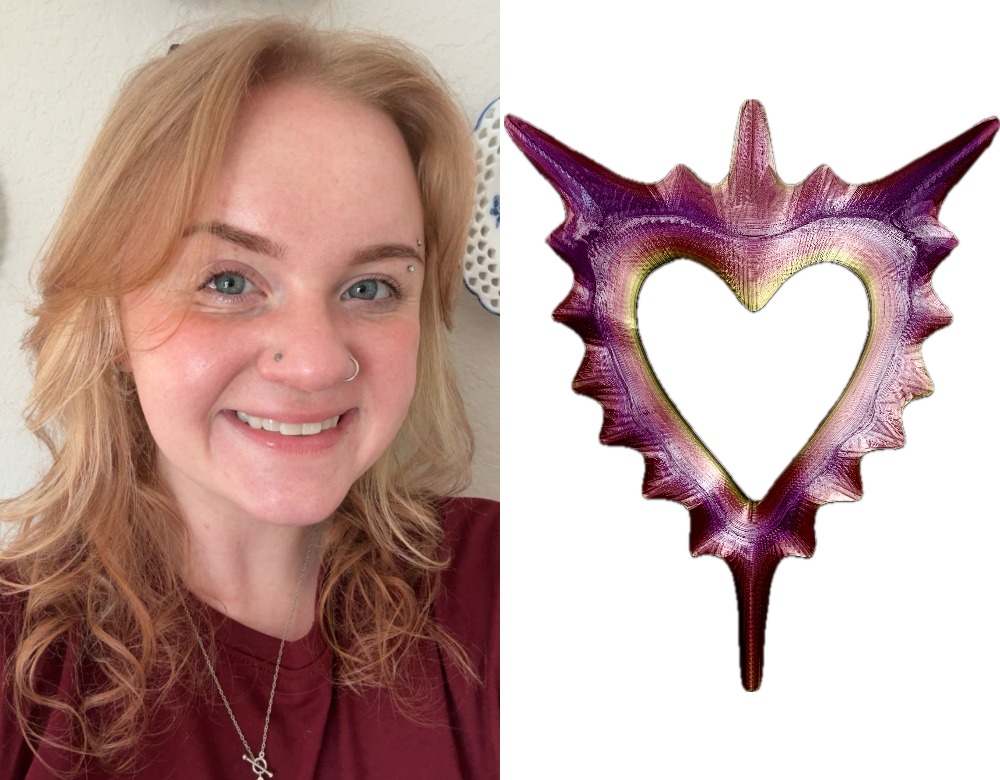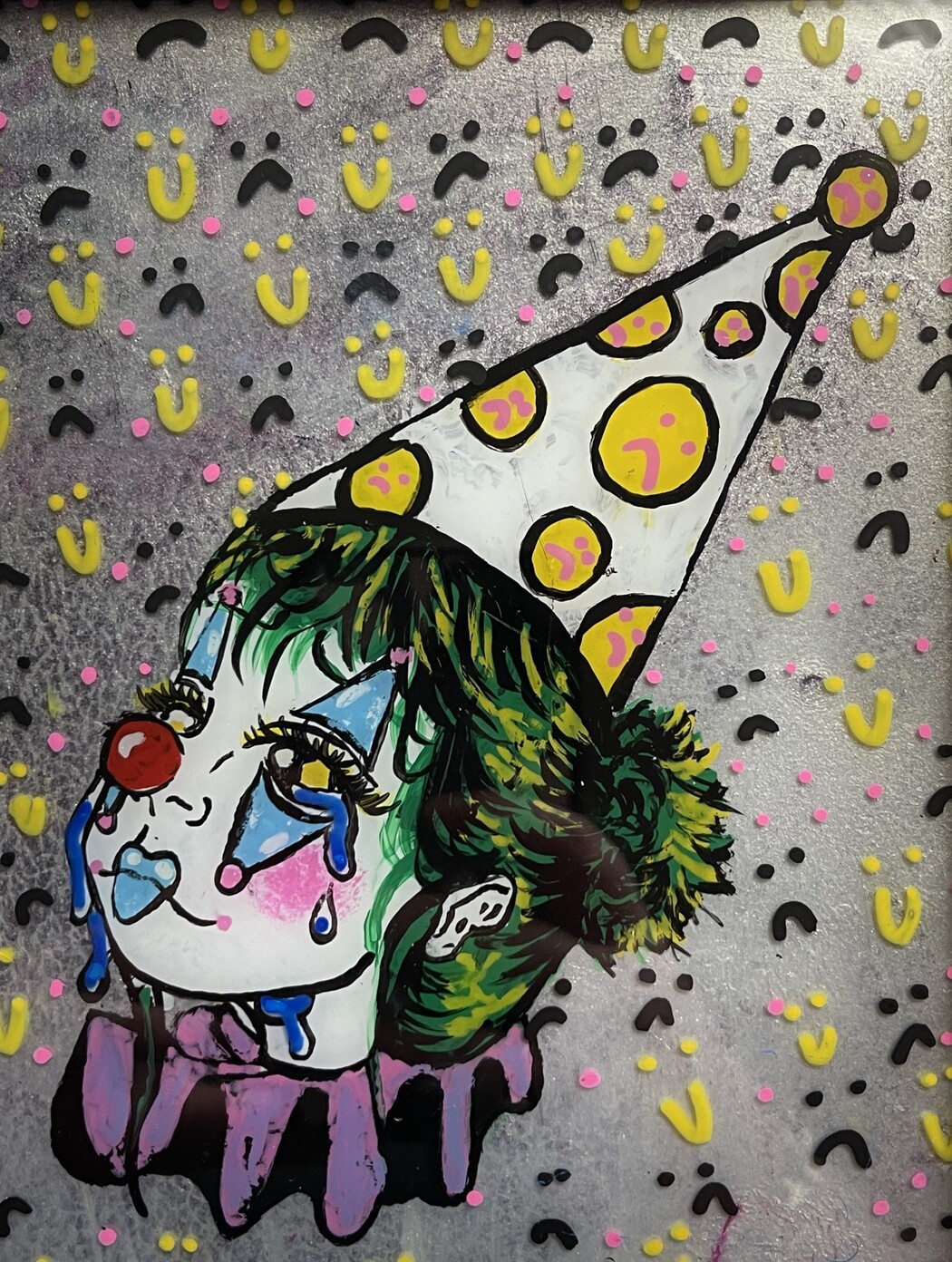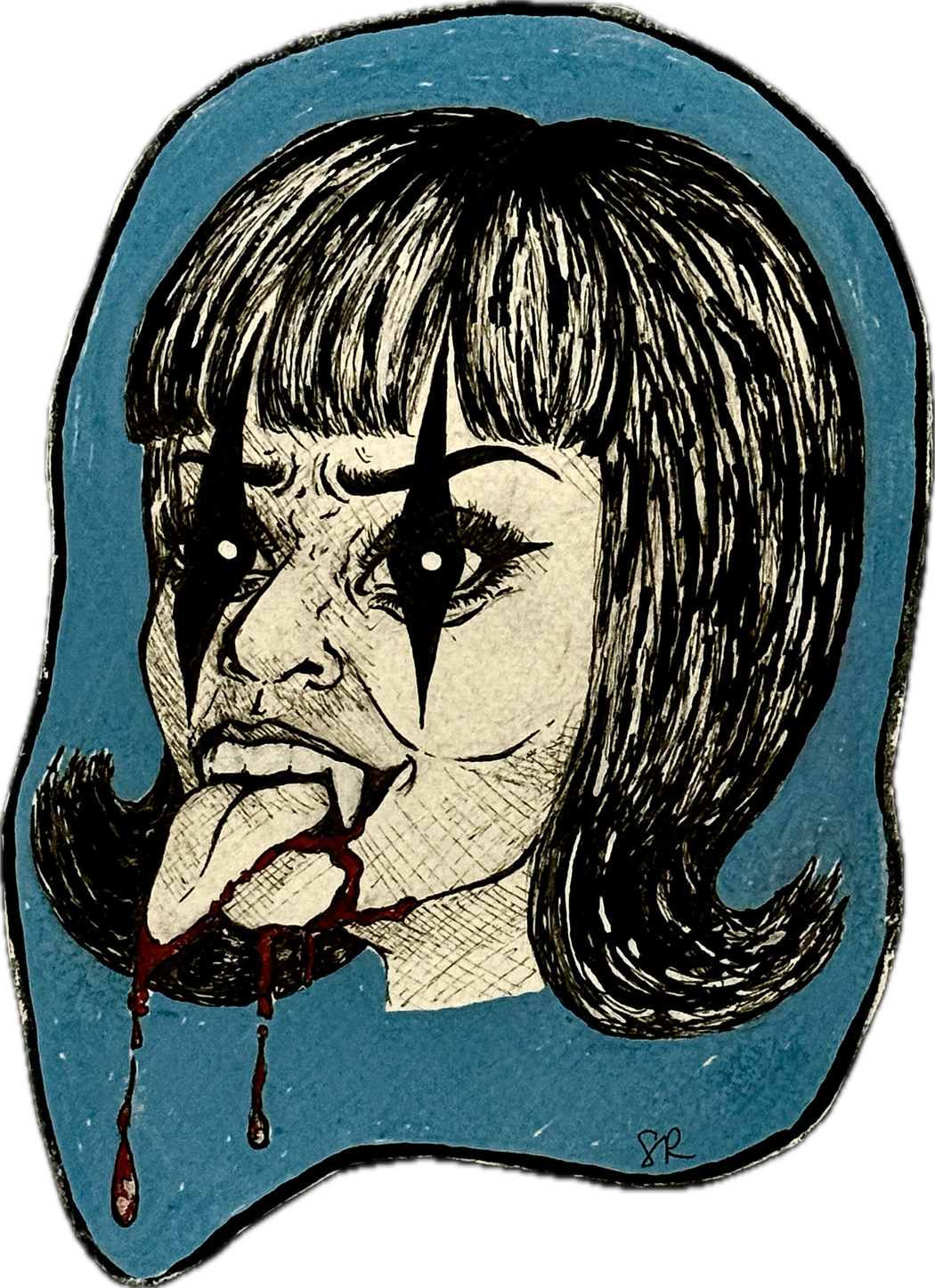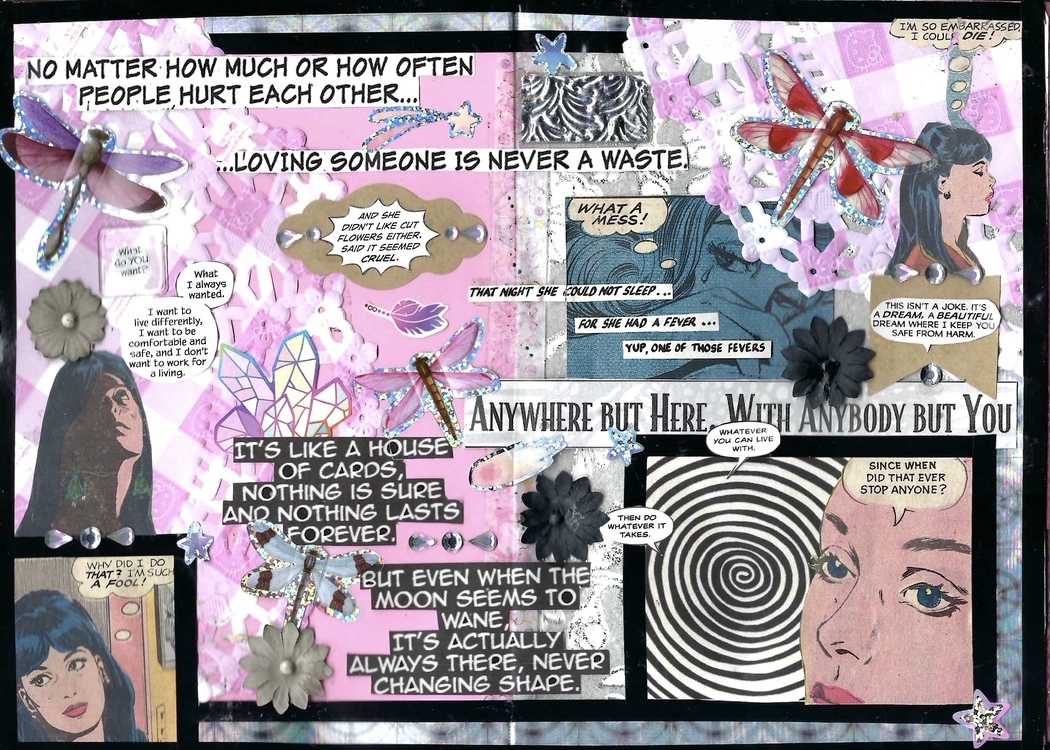Skylar Rains
Year of birth: 1998.
Where do you live: Atlanta, GA.
Your education: Graduate of Visual Arts from New Orleans Center for Creative Arts and B.F.A. of Sculpture from Savannah College of Art and Design.
Describe your art in three words: Edgy, Vivid, Introspective.
Instagram

Your work blends light, airy themes with darker, more complex emotions. How do you balance these contrasting elements in your creative process?
I’ve realized these elements don’t feel so opposing when I step back and look at the bigger picture of how I process emotions. My mind doesn’t do black and white anymore. I spent a lot of time trying to categorize, trying to make decisions that felt final — like I needed to define what something was or wasn’t, and that would be the end of it.
But I don’t approach things that way now. At this point in my life, I try to take an honest look at all the emotions I carry. I let myself feel them fully, even when they’re contradictory. I’ve found that both can be true — light and dark, hope and heaviness — existing at the same time, layered over each other.
It’s that overlap that stands out to me. That space where things blur instead of separate. That’s where I’ve found a kind of balance, especially in my art. It’s why I’m drawn to using bright colors paired with darker imagery. It reflects how I hold things internally — not as opposites fighting for space, but as parts of a whole that inform each other.
You’ve had a strong connection to New Orleans and its culture. How has your background shaped your work, especially considering the impact of Hurricane Katrina on your life?
Being from New Orleans — going through what I went through, and pushing myself into a new life — has tied me to the very place that hurt me most. My old life there held both trauma and triumph. The Big Easy is rich in culture, so unique and diverse, but there’s also a profound darkness that runs through it.
I grew up surrounded by art, music, and food. Cajun and Creole culture shaped me as an artist. Swamp paintings, jazz in the streets, crawfish boils — those are the things that make me feel most like myself.
Middle school is when I started to bloom creatively. I painted to ease my mind, bounced from clarinet to guitar to bass, and found joy in experimenting in the kitchen. That’s when I became Skylar Rains, the artist.
But there’s another side to New Orleans — alcoholism, illness, mental health struggles, addiction. If it’s not us, it’s someone we love. For me, it was my father, my mother, my brother… and the list goes on. The culture celebrates life, but it also enables these vicious cycles.
When Hurricane Katrina hit, I was six. Our home flooded with seven feet of water. I lost everything and my six-year-old brain couldn’t grasp why we weren’t going home. But there was no home left.
Losing our safety changed everything. And when your whole city is gone, there’s no words for that.
All of this — what I’ve seen, what I’ve survived — shapes the balance I carry into my work. I come from one of the most vibrant places on earth, but its shadow follows close behind.
 Skylar Rains | Crying so I Dont Laugh | 2024
Skylar Rains | Crying so I Dont Laugh | 2024
As a 3D designer and fabricator, how does your technical expertise influence your artistic practice? Do you see these two aspects of your work as interconnected or separate?
I have no choice but to let my technical side connect with my artistic side — they’ve become inseparable. Since attending New Orleans Center for Creative Arts, and later when I took the leap and moved to Atlanta to attend Savannah College of Art and Design, I’ve been grounded in traditional training. But things really started to shift when I started working as a laser cutting tech at SCAD. That’s when my creative process and technical knowledge started to merge, and new possibilities opened up.
I understood early on that the workforce values artists who know how to work with technology. That awareness helped shape my path, and it’s what allowed me to succeed in my career at Arc Design and Fabrication. As a fabricator, I’ve been trusted to operate CNC routers, plasma CNC machines, and 3D printers — tools that completely changed the way I see and approach my own work. In addition to fabrication, I also engineer the shop and production drawings for Arc, which has given me a deep understanding of how things are built and how to communicate that process clearly through 2D visuals.
I’ve developed a broad skill set — building furniture, working on brick-and-mortar spaces, and creating custom art pieces. These parts of my job demand precision, math, and intention. That mindset has carried over into my personal work, pushing me to level up both conceptually and in craftsmanship. I carry these skills with me, no matter what medium I’m working in.
But my practice isn’t always so technical. I still return to painting, collaging, and sculpting without digital tools — just hands, materials, and feeling. That space is just as important to me. Once again, it’s the balance between structure and spontaneity, between analog and digital, that defines who I am as an artist. It’s in that intersection that I’ve found my voice.
 Skylar Rains | Spiking My Heart | 2023
Skylar Rains | Spiking My Heart | 2023
Your work often explores symbolism and color to express emotions. Can you share a piece that best represents this approach and the feelings behind it?
“Spiking My Heart” is a strong example of how I use color and symbolism in my work. The ombré of pink, purple, and yellow feels like a sunset on the horizon — like a setting of emotion or circumstance. But the heart at the center is surrounded by spikes. That’s where the tension lives.
Emotions set. They pass through us, just like a sun going down. But the pain points — those stay. Even when I let go of a person or situation, the impact lingers. It leaves something behind that permanently changes the shape of my heart.
The title is in the present tense for a reason. “Spiking” isn’t something that happened and ended — it’s something I carry forward. My heart is still whole, always will be, no matter who comes or goes, no matter what hurts me. The spikes don’t shatter me — they reshape me. They teach me how to adapt to the new pain point and grow around it. There’s something bittersweet but beautiful about that.
Nothing and no one will hurt me the way I’ve been hurt before. I’ve already survived the worst of it. So when a new spike appears, I wear it like a badge of honor. It means I allowed myself to feel. To love. To break open and keep going. I don’t let pain define me — I let it spike me. And in that spiking, I evolve.
How do you decide which medium to work with for a particular project? Do you feel certain themes or concepts are better suited to specific materials or techniques?
I tend to get into “kicks” with whatever medium’s calling to me at the time. Sometimes it’s clay, sometimes I stumble across a stack of old magazines and cut them to shreds. I might want to get messy with paint, or lean into something more technical just to see where it takes me. It really depends on where I’m at mentally and emotionally — it’s all pretty instinctual.
I don’t usually start with a clear concept. I let the materials guide me. When I try to force a plan or overthink it, I get stuck. The piece doesn’t get finished. It starts to feel like work — like pressure — which I already deal with enough in my day job. In my personal work, I need freedom to just respond in the moment.
That’s where balance shows up for me. I’m not letting the material talk for me, and I’m not talking at it either. It’s more of a conversation — something I’m feeling out in real time. There’s this push and pull, a kind of rhythm that lets me stay connected to the process. That balance between control and flow, structure and spontaneity, is where the work feels most like me.
 Skylar Rains | Grinding Til the Blood Puddles | 2025
Skylar Rains | Grinding Til the Blood Puddles | 2025
Your portfolio includes everything from painting to sculpture and mixed media. What’s the most challenging medium for you to work with, and why?
Sculpture has always been the most challenging and the most rewarding. Taking a concept and giving it physical life, shaping it into something real in the 3D, is never simple. But that’s what makes it so meaningful.
One of my earliest sculpture teachers told my class, “If you’re not here to fail, you’re not in the right place.” That stuck with me. It’s something I’ve carried into every part of my life. It was also the moment I truly fell in love with sculpture — not just as a medium, but as a way to learn, to explore, and to grow. It became about the process: experimenting, making mistakes, and still finding a path to the end goal.
For me, sculpture is something that, in theory, could go on forever. There’s always more to add, more to take away — reshaping, sanding, refining. I had to learn when to step back, to stop obsessing over every tiny detail and start seeing the whole. That mindset has become part of who I am, both in and out of the studio.
 Skylar Rains | Lover Girl | 2024
Skylar Rains | Lover Girl | 2024
What role do you think vulnerability plays in your work? How do you embrace and convey vulnerability through your art?
Vulnerability is part of my process — it always has been. I don’t really have a choice in that. It’s not something I can turn off or hide from; it’s woven into who I am. A lot has happened in my life, and the only way I’ve been able to access the parts of myself that hold those truths — the emotional weight, the memories, the things that are hard to say out loud — is through making art.
I became an artist because I needed a way to release what I was carrying. My creativity started as a way to process the traumas and emotions I’ve held onto since childhood. There’s something healing about sitting down with no plan and just letting it all come through. That’s where the vulnerability lives — in the surrender.
When I create, it’s almost like I’m accessing something deeper than conscious thought. The noise of the world quiets, and it’s just me and the work. The art becomes the conversation I’m having with my own emotions, even when I don’t have the words for them yet.

Leave a Reply
You must be logged in to post a comment.